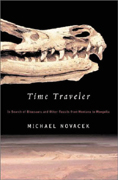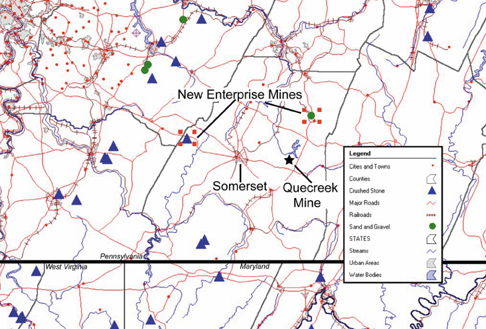
by Michael Novacek. Farrar, Straus and Giroux (2002), ISBN 0-374-27880-6, Hardcover, $26.
Louis L. Jacobs

Check out this month's On the Web links, your connection to earth science friendly Web sites. The popular Geomedia feature now available by topic.
Book Review:
Time Traveler: In Search
of Dinosaurs and Ancient Mammals from Montana to Mongolia
Maps:
Aggregates
map helps save Quecreek miners
 |
Time Traveler:
In Search of Dinosaurs and Ancient Mammals from Montana to Mongolia by Michael Novacek. Farrar, Straus and Giroux (2002), ISBN 0-374-27880-6, Hardcover, $26. Louis L. Jacobs |
Michael Novacek, a distinguished paleontologist at the American Museum of Natural
History, is probably best known to the public for his work on the spectacular
fossils of Mongolia. These fossils were the subject of his first book, Dinosaurs
of the Flaming Cliffs. Time Traveler is his second book, and his
acknowledgements make it clear that he wrote it because he and his readers enjoyed
the passages in his first book about his learning to be a paleontologist, his
feelings and experiences.
In Time Traveler, Novacek expands on these themes and delves into his
fieldwork prior to Mongolia. He states that the book is not “a book about
a life, but largely about a life in the field.” In that sense, it is an
autobiography, albeit an unconventional one. His “recollections are meant
to show how a childhood of dinosaur dreams was transformed into a paleontological
career.” The book is just what Novacek promises. Time Traveler is
a primer for a successful career in paleontology.
Together, the book’s many themes give it many layers and serve a broad
audience. Consequently, as one might imagine, depending on the experiences and
expertise of the reader, not all parts of the book are equally informative or
entertaining. Thus it is a good but somewhat hummocky read, speeding up and
slowing down like a field vehicle crossing the badlands.
The first three chapters describe Novacek’s childhood in Los Angeles, his
desert explorations, and his affection for the Santa Monica Mountains. He describes
a trip to the Grand Canyon with his family to introduce principles of stratigraphy
and time. He discovered his first impressive fossil, a trilobite, in Wisconsin,
where his family moved for a short interval before returning to southern California.
He enters a rock-band musical phase, which segues into his undergraduate years
at UCLA.
In his narrative, Novacek is kind to his paleontology professors. They obviously
recognized in him the talent that has since blossomed, and he responded to their
consideration. His paleontological fieldwork began with Peter Vaughn of UCLA
in Paleozoic rocks of the Colorado Plateau and southern New Mexico, a spectacular
but difficult field area that yields its treasures begrudgingly, as described
in six chapters. Novacek uses these chapters to provide further background in
geology and paleontological methods.
This section also hosts a few errors: In a discussion about coprolites, he explains
the process of CAT-scanning, which he incorrectly calls “cathode axial
tomography” (instead of computed axial tomography) and which he says uses
“lasers to make an internal image map” (instead of X-rays). These
are only errors; I was hurt to read Seymouria unkindly referred to as a “sluglike
labyrinthont amphibian.” How could this glamorous amphibian misfit with
brawny terrestrial limbs be likened to an askeletal mollusk? But this is just
a paleontologist’s infatuation with the extinct.
In the early 1970s, after a stint as a crew chief in the La Brea Tar Pits, Novacek
set off for San Diego, continuing his fieldwork in the wilds of urban paleontology.
At San Diego State University he studied under Jay Lillegraven (now at the University
of Wyoming). Under Lillegraven’s tutelage, Novacek completed a thesis on
the insectivoran mammals from late Eocene sediments in San Diego and its environs.
With his thesis, Novacek began to define his place in the profession. He pursued
his doctoral studies under Don Savage and Bill Clemens at the University of
California, Berkeley. Through them he participated in fieldwork in the classic
badlands of the Bighorn and Washakie basins in Wyoming, and Crazy Mountain Field
and the Hell Creek Formation in Montana. These chapters afford the opportunity
to discuss the colorful history of paleontology in western North America.
After completing his doctorate, Novacek took a position at his alma mater in
San Diego, Lillegraven having moved to Wyoming. But Novacek was not in San Diego
long before he migrated permanently to the American Museum of Natural History
in New York.
His time in San Diego led him to fieldwork in Baja California, the first field
project that was truly under his direction. The locality was known from earlier
work and the fossils were said to be Paleocene. Novacek’s team found more
fossils, including the placental Hyopsodus, which a missing comma on
p. 169 transforms into an opossum-like marsupial; and Meniscotherium,
which for the same reason became a rodent. But those who know the names will
know the taxa and the editing will not matter. The new fossils Novacek and his
team found there indicated an Eocene age. They utilized the systematics of fossil
vertebrates, marine and nonmarine stratigraphy, and magnetostratigraphy to dispel
the notion of asynchrony of early Eocene mammalian faunas of North America,
a conclusion that would have relevance in later years as the global climate
controversy heated up.
Following Baja, Novacek tackled Chile, to which five chapters are devoted. He
took a nasty spill from a horse, the last of a number of calamities chronicled
in the book, but continued in his fieldwork. The description of the discovery
of the Tinguiririca fauna is my favorite part of the book because it was real
discovery from the beginning. No one had ever found bones there before, and
the find was in rocks that represented an interval of geologic time not previously
known in South America.
From South America, Novacek’s search led to Yemen in the southern portion
of the Arabian Peninsula. Pickings were slim, but the country is fascinating
and he describes its mountains and deserts well. One legendary home of the Queen
of Sheba is Marib on the sandy edge of the Empty Quarter of Arabia, Novacek’s
last stop in the country.
From the sands of Arabia, Novacek traveled to the sands of Mongolia, the subject
of his first book. Here he provides more background into how he got there and
presents some interesting results. The magnificent and numerous skeletons, including
dinosaurs brooding on nests, were preserved between ancient dunes when rainstorms
triggered mud flows down the slopes. On the slope faces, dinosaur tracks were
found going uphill, as footprints preserved on dune faces most often are. Interestingly,
a modern analog in many ways to the Cretaceous environment of Mongolia might
now be found in Arabia Felix, in the dunes and interdunes around Marib.
The impression is that he was not overly fond of Marib as a town, although Novacek
does provide a Web address in the notes to lead the reader into the archaeological
wonders of Yemen, and he mentions the archaeological ruins protruding from the
sand around Marib.
Novacek notes the threat commercial collectors pose to the paleontological resources
of Mongolia. One can only imagine what we would not know had the resources been
sold off and had the American Museum not built a long history of fieldwork and
study in Central Asia.
What will we lose if access to the field and its study is removed for shortsighted
gain? It gives pause to contemplate the responsible management of fossil resources
on public lands in the United States, a great concern to the paleontological
profession, to museums, and to the broader paleontological and educational communities.
The book closes with a consideration of the value of paleontology to humanity,
specifically the perspective it gives to extinction and the current biodiversity
crisis. While few pages are devoted to the topic, I consider this one of the
most important parts of the book because it is profound. Certainly, extinction
would be viewed differently if we had no fossil record; even if, as Novacek
points out, we do not need fossils to know about the current biodiversity crisis
and its causes. I would add two other contributions of the fossil record in
this solemn vein. Firstly, the fossil record contributes significantly to our
understanding of evolution and tangibly to the recognition that all biological
variations, physical or otherwise, are trivial compared to the realization that
we all share a common ancestor and a common history.
Secondly, fossils remain the primary data for determining time and place in
Earth history.
Now, with concerns of global warming looming large, the fossil record is invaluable
in documenting intervals of climatic anomaly. A case in point derives from Novacek’s
work in Baja. He and his team were focused on correlating early Eocene fossil
localities, including those on Ellesmere Island. That locality, above the Arctic
Circle, contains alligators and other warmth-loving creatures, and therefore
provides certain indication of a warmer global temperature compared to now.
The fossil record is instrumental in establishing boundary conditions for understanding
past climates and avenues for investigating the mechanisms of climate change.
More importantly perhaps, paleontology brings the uniqueness of our times into
focus. Now is the first time in Earth history humans have been subjected to
extensive global change precipitated by us and over which we have control.
 The
rescue of nine coal miners trapped in a flooded shaft in Somerset, Pa., in July,
involved dozens of agencies and organizations, with hundreds of people pooling
their resources. One of those people was Val Tepordei, and he didn’t even
know it. His efforts to create an Aggregates Industry Atlas CD four years ago
enabled nearby local quarries to aid in the Quecreek mine rescue.
The
rescue of nine coal miners trapped in a flooded shaft in Somerset, Pa., in July,
involved dozens of agencies and organizations, with hundreds of people pooling
their resources. One of those people was Val Tepordei, and he didn’t even
know it. His efforts to create an Aggregates Industry Atlas CD four years ago
enabled nearby local quarries to aid in the Quecreek mine rescue. |
Geotimes Home | AGI Home | Information Services | Geoscience Education | Public Policy | Programs | Publications | Careers |